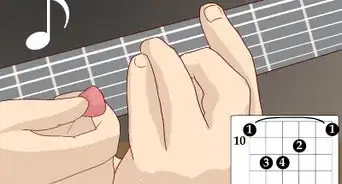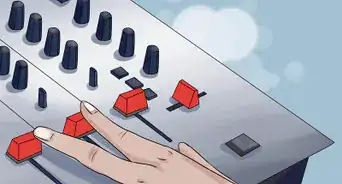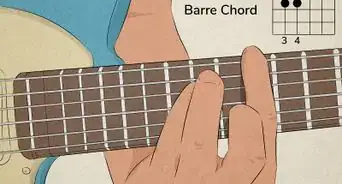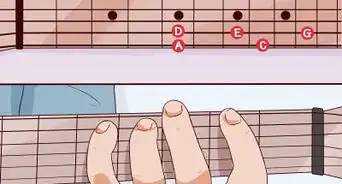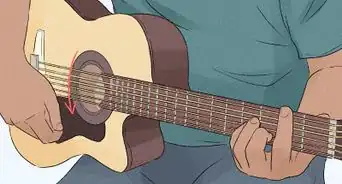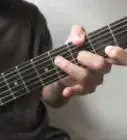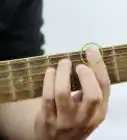This article was co-authored by Aaron Asghari. Aaron Asghari is a Professional Guitarist and the lead guitarist of The Ghost Next Door. He received his degree in Guitar Performance from the Guitar Institute of Technology program in Los Angeles. In addition to writing and performing with The Ghost Next Door, he is the founder and primary guitar instructor of Asghari Guitar Lessons.
This article has been viewed 24,767 times.
Changing chords is one of the most basic skills a guitarist can have, yet it is also one of the most difficult feats for brand new players. Chords are hard to play even when you aren't switching from one to the other, but with some improvements to technique and new practice exercises, you can start changing chords smoothly like a pro.
Steps
Improving Chording Technique
-
1Learn your chords cleanly, without transitions, before trying to switch between them. Make sure you can play the chords smoothly on their own. Strum each note of the chord individually, making sure they don't buzz or sound dead. If you can play each note in a chord cleanly every time, then changing chords will be easy. For this article, you can practice with any chords you want. For starters, you might work on shifting back and forth between a C and a G-major chord, two of guitars most common chords.
-
Open G-Major:
- --1--
- --0--
- --0--
- --0--
- --2--
- --3--
-
Open C-Major:
- --0--
- --1--
- --0--
- --2--
- --3--
- --X--
-
Open G-Major:
-
2Loosen and relax your body into a comfortable, smooth playing position. Keep your wrist relaxed and lightly bent, as if you were cupping an apple in your hand. A relaxed wrist and fingers are key to moving quickly and easily along the fretboard. Your elbow should be tucked in, towards your ribs instead of splayed out, and your strumming hand should be able to move freely from the wrist.
- A relaxed body can move more fluidly, smoothly, and quickly.
- Your fretting wrist (your left hand, for right-handed players) isn't kinked in front or behind of the neck, it is almost perpendicular to the frets, if not leaned a bit forward.
Advertisement -
3Always fret with the tips of your fingers, not the pads. The small, hard spot on the tip of your finger is infinitely more precise than the fleshy pad. For faster, smoother transitions, always fret with the tips, curling your fingers away from the guitar to make it easier to land on the fingertips.
- If you can't reach the frets comfortably with your fingertips, raise your left knee (for right-handed players) to lean the guitar upwards, classical style. The upward angle makes it easier to get your fingers around the neck.
-
4Keep your fingers as close to the back of the fret as possible. If you're playing a note on the 3rd fret, you could technically be anywhere between the second and third frets with your fingers. But you'll get the most consistent, even sound if you're as close to the back of the 3rd fret as possible. Always try to creep closer to the fret you're trying to play for the cleanest transitions and chords.
-
5Keep practicing to build strength and stamina. Chords take a lot of strength for beginning guitarists. So don't get discouraged when you have difficulties at first -- all guitarists need to build the physical skills as well as the musical skills of playing. The best way to build strength is to keep playing.
- Play a tough chord, remove your hand, then play the chord again. Keep repeating this on-off pattern to get faster and stronger with quick chords.
- Close your eyes to think about what a chord "feels" like. Can your fingers get there without your eyes?[1]
Practicing Chord Transitions
-
1Start with just two chords, working until you can shift the two perfectly. This is good whether you're learning new chords or practicing a particular transition. Don't complicate things by trying to transition out of ten different chords. For example, if you have trouble getting to C-major, just practice transitioning between C and G until you have it down, then move to C and F, or C and Am.
-
2Start at a speed where you can sound out each chord perfectly. Never sacrifice the quality of the chord to play it faster -- it doesn't matter how speedy you are if the notes sound terrible. Start with slow, easy transitions -- don't strum the chord until you feel like all of your fingers are set well.
-
3Slowly raise your speed as you get more comfortable. You can use a metronome, slowly raising the BPMs (Beats Per Minute), or just your own ear. You want to remain in control, always hitting all the notes cleanly, but you must start to practice at a faster clip to become a faster guitarist. Using a metronome helps you gauge your progress and set benchmarks for faster BPMs.
-
4Reverse the order of your chords to cement your knowledge. It may seem small, but going from a C to a G is different than from a G to a C. You need to practice chord transitions from both directions, so don't just get stuck practicing the same old motion.
-
5Anticipate the chord changes as they come up. While you never want to rush a song or chord, good players are thinking of the next chord while they're playing the current one. If you know you're going to a C-chord soon, think about the upcoming shape so you aren't caught off guard.
-
6Apply your chord progressions to real music, not just a metronome, to really learn transitions. At the end of the day, you should always apply the skills you practice to real songs and music, helping you put all the skills together in a more enjoyable, helpful way. While metronomes are helpful, real music has a natural swing and feel to it that you only learn by playing real songs. When possible, practice with other musicians, too.
- Try out Wikihow's "Play Simple Guitar Songs," for a basic songbook with easy chord transitions.[2]
Expert Q&A
-
QuestionWhat is the best amp for an acoustic guitar?
 Aaron AsghariAaron Asghari is a Professional Guitarist and the lead guitarist of The Ghost Next Door. He received his degree in Guitar Performance from the Guitar Institute of Technology program in Los Angeles. In addition to writing and performing with The Ghost Next Door, he is the founder and primary guitar instructor of Asghari Guitar Lessons.
Aaron AsghariAaron Asghari is a Professional Guitarist and the lead guitarist of The Ghost Next Door. He received his degree in Guitar Performance from the Guitar Institute of Technology program in Los Angeles. In addition to writing and performing with The Ghost Next Door, he is the founder and primary guitar instructor of Asghari Guitar Lessons.
Professional Guitarist & Instructor While you can plug an acoustic guitar into a regular amp, it's best if you can use an amplifier designed specifically for acoustic guitars. These tend to produce the best sound.
While you can plug an acoustic guitar into a regular amp, it's best if you can use an amplifier designed specifically for acoustic guitars. These tend to produce the best sound.

